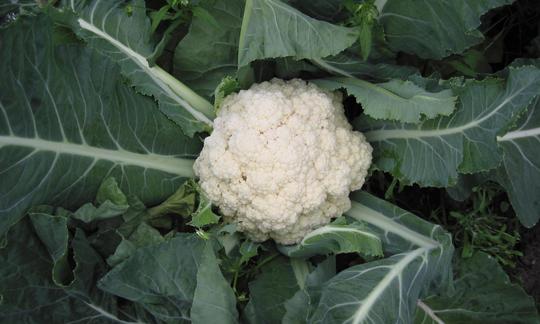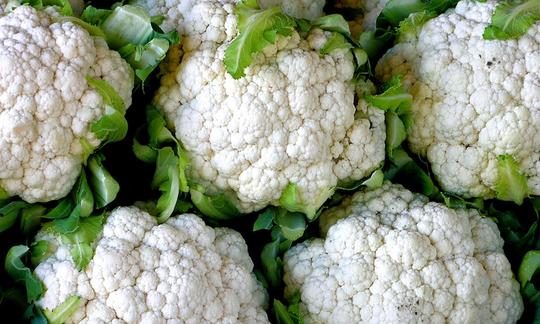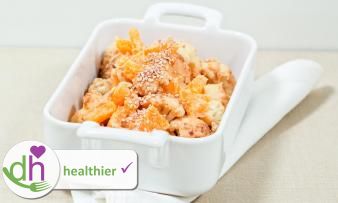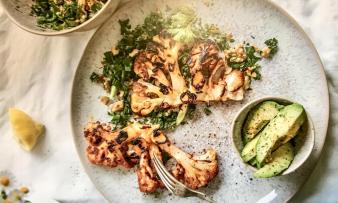Table of contents
Cauliflower ( Brassica oleracea var. botrytis) is a cultivated form of cabbage and a very popular type of cabbage. It can be prepared both raw and cooked - preferably in organic quality.
Use in the kitchen
The edible part of cauliflower is the inflorescence of the plant before it blooms. Cauliflower, which is usually white, also comes in green, yellow and purple varieties. A variety that is becoming increasingly popular is the yellow-green Romanesco with its striking, geometric structure (Fibonacci spirals). Cauliflower has a subtle, mild taste that even people who are less keen on cabbage will enjoy.
Can you eat cauliflower raw? Cauliflower can be eaten raw. How do I prepare cauliflower? Regardless of whether you want to eat cauliflower uncooked or cooked, the best way to prepare it is as follows: remove the green leaves, cut off the stalk with a knife, separate the small florets and rinse under running water. How do you cut cauliflower? You can also prepare the head whole and then separate it or cut it into slices. The more tender leaves and the peeled stalk, which tastes similar to kohlrabi, are also edible.
If you want to eat the cauliflower cooked, you can stew, steam, roast, bake, gratinate or even deep-fry it. It is best digested when it is steamed briefly and seasoned with just a little lemon juice and oil - the acid also keeps it nice and white. Avoid cooking it for too long, as this will damage the taste, consistency and nutrient content. The florets need 3-5 minutes to be firm and 5-8 minutes to be soft. The cooking time for a whole head of cauliflower is around 12-20 minutes, depending on the size.
Steamed cauliflower goes well with creamy sauces such as béchamel sauce, hollandaise sauce or mustard sauce - all of these can of course be easily prepared vegan. Vegetable, potato, chickpea or lentil curries with cauliflower are also very popular - broccoli and spinach go well with them. The cabbage can also be made into fine soups (e.g. cauliflower and parsnip soup) and purees (e.g. with peas). It is also excellent as part of a vegetable stew or as a vegan Bolognese with pasta. Also recommended are crispy cauliflower wings baked in the oven - served with a vegan BBQ or sweet and sour sauce. If you would like to conjure up a meat-free winter dish, you can fry raw cauliflower, for example marinated, pan-fried cauliflower steaks with mashed potatoes and vegan gravy. Cauliflower can also be used to make casseroles (e.g. with pasta or potatoes) or gratins topped with vegan cheese. An unusual but highly recommended use is to make a gluten-free, vegan and low-calorie pizza dough.
Young and tender cauliflower is particularly suitable for eating raw. The cauliflower florets can be used to make a wonderful raw cauliflower salad (raw food) with all kinds of ingredients (e.g. tomatoes, cucumbers, sweet peppers, red onions, olives, mung bean sprouts). If you shred the florets, you can make cauliflower tabbouleh (instead of bulgur). The crumbs can also be used as a rice substitute, i.e. as raw cauliflower rice. If you want to eat cauliflower raw, you can also prepare delicious curries ( cauliflower-parsnip curry, raw) or vegan sushi.
Many herbs go well with cauliflower - parsley, basil, chives are particularly suitable, but also coriander, lemon balm or mint. You can simply season it with salt andpepper, or if you like it more intense, use garlic granules, curry, ginger (ground), nutmeg or cumin.
Vegan recipe for cauliflower tabbouleh (raw cauliflower salad)
Ingredients (for 2 people): 400 g cauliflower (raw, organic), 5 tbsp lemon juice, 1 pinch of sea salt, 1 mango, 1 small cucumber, 150 g red cabbage, 1 tbsp tahini, 2 tbsp rice vinegar, 2 tsp soy sauce, 1 pinch of chili flakes, 3-4 tbsp water, ½ bunch of coriander, 70 g pomegranate seeds.
Preparation: Remove the leaves and stalk of the cauliflower, separate the florets, wash and shred with a blender to the size of bulgur. Mix with 3 tablespoons of lemon juice and a pinch of sea salt. Dice the mango flesh and the washed cucumber with the peel. Wash the red cabbage and finely slice or chop. Put everything in a bowl and mix. For the dressing, mix together the tahini, rice vinegar, soy sauce, 2 tablespoons of lemon juice, chili flakes and water. Rinse the coriander, shake dry and chop. Mix the dressing into the vegan cauliflower tabbouleh and garnish with coriander and pomegranate seeds.
Vegan recipes with cauliflower (raw) can be found under the note: " Recipes that have the most of this ingredient ".
| Not only vegans or vegetarians should read this: Vegans often eat unhealthily. Avoidable nutritional errors. |
Purchasing - Storage
Raw cauliflower can be bought in many supermarkets (e.g. Coop, Migros, Denner, Volg, Spar, Aldi, Lidl, Rewe, Edeka, Hofer, Billa) and organic supermarkets (e.g. Alnatura, Denn's Biomarkt) mostly all year round. Cauliflower is in its peak season in the DA-CH countries from May to November (December, depending on the region) and can be bought regionally in supermarkets. In the remaining months it is imported from Italy or the Netherlands. 14 In addition to fresh cauliflower heads, retailers also offer frozen cauliflower florets and sometimes even canned cauliflower salad in jars.
The availability of cauliflower varies depending on the size of the store, catchment area, etc. If you are interested, click on our recorded food prices for the DA-CH countries (above under the ingredient image). There you will find current prices from various supermarkets and their price development.
Storage tips
Cauliflower should be stored in the vegetable compartment of the refrigerator. It will stay fresh there for four to five days. If it starts to smell, this indicates that it has been stored for too long. Dark spots are mostly caused by fungal infestation. So always make sure the head is plump and uniform in color and the leaves are crisp and fresh. If you have too much cauliflower at home, you can also freeze it, raw or briefly blanched. To do this, cut the cauliflower into individual florets and blanch them briefly in salt water. The florets go in airtight freezer bags or containers in the freezer, where they will keep for up to 12 months.
Ingredients - Nutritional values - Calories
With 25 kcal and 0.28 g fat per 100 g, cauliflower (raw) is very low in calories and almost fat-free. Other cauliflower nutrients such as proteins (1.9 g/100g) and fiber (2 g/100g) are also rather low. 1
Raw cauliflower is rich in vitamin C (48 mg/100g; 60% of the daily requirement). Pak choi (45 mg/100g) and red cabbage (57 mg/100g) contain a similar amount. Yellow bell peppers contain a particularly high amount of vitamin C at 184 mg/100g . 1
In addition, raw cauliflower contains 57 µg/100g of folate (29% of the daily requirement). Radicchio (60 µg/100g) and Brussels sprouts (61 µg/100g) have similar contents. Edamame contain over five times as much folate at 303 µg/100g. 1
Does cauliflower contain vitamin K? The vitamin K content of cauliflower is 16 µg/100g (21% of the daily requirement). This is similar to that of artichokes (15 µg/100g) and carrots (13 µg/100g). Significantly more vitamin K can be found in chard (830 µg/100g). 1
The complete ingredients of cauliflower (raw), the coverage of the daily requirement and comparison values with other ingredients can be found in our nutrient tables. In the article Nutrients explained you will get a detailed insight into the topic.
Effects on health
Cauliflower and cruciferous vegetables in general contain a number of secondary plant substances that have a positive effect on human health. Cauliflower extracts, dissolved in water and ethanol, have a high antioxidant activity. Natural antioxidants are also said to have antibacterial, antiviral, antifungal, anti-inflammatory, antiallergic, antithrombotic and vasodilatory effects. 2 In addition, they induce detoxification enzymes, stimulate the immune system and reduce the risk of cancer. 3 The carcinogenic effect of cauliflower is attributed to the secondary plant substances, the glucosinolates (glycosides and indoles). 3,4
Due to its low calorie content and long-lasting satiating properties, eating cauliflower is particularly recommended for people who are overweight and is also suitable for diabetics. It also has a digestive effect and can help with all kinds of digestive disorders, such as constipation, diarrhea, colitis, etc. Compared to other types of cabbage, cauliflower is easier to digest and is therefore usually more suitable for people with stomach diseases such as gastritis and stomach ulcers than other types of cabbage. 4
A potential medical application can be seen in cardiovascular disorders and kidney diseases. For people suffering from cardiovascular diseases (eg heart disease, high blood pressure, arteriosclerosis), cauliflower can be a beneficial food due to its low sodium and fat content and the presence of potassium. Since it is also diuretic and blood purifying, it can provide relief for kidney failure, arthritis, gout, kidney stones and kidney-related edema. 4
Dangers - Intolerances - Side effects
In people with sensitive digestion, cauliflower can stimulate the formation of intestinal gases due to its high cellulose content and thus lead to flatulence. Caution is also advised in the case of cholelithiasis (gallstones). Although cauliflower can help with stomach and intestinal complaints, it can also cause digestive disorders due to dyspepsia (various upper abdominal complaints). 4
Folk medicine - natural medicine
Cauliflower has been used for medicinal purposes since ancient times. In folk medicine, complaints such as diarrhea or headaches are still treated with cauliflower. The boiled leaves are said to improve complaints such as hoarseness and inflammation of the bronchial mucosa. 5
Ecological footprint - animal welfare
The ecological CO 2 footprint of regional cauliflower is relatively low at 0.2 kg CO 2 e/kg and is similar to that of regional eggplants or apples. 15 The amount of water required to produce 1 kg of this vegetable is also comparatively low at 285 liters and is significantly lower than that of, for example, asparagus (2150 L/kg) or artichokes (818 L/kg). 16 The greatest potential for savings for more climate-friendly cultivation lies in the irrigation system. This particularly applies to countries such as Spain, where water scarcity plays a major role and the most efficient irrigation possible is important. 17
The proportion of organic cauliflower is still relatively small. However, the increasing impoverishment of varieties in conventional agriculture is leading to more interest in the variety of varieties that organic farming could offer. 10 In addition, chemical fertilizers and synthetic pesticides are not used in organic farming, which is preferable for the sake of one's own health and nature.
A study shows that cauliflower is a profitable cultivation system when grown as an environmentally friendly intercrop with other vegetables (e.g. salads such as romaine lettuce or lettuce, beans or onions). Various mixed culture systems produce higher yields compared to cauliflower cultivation in monocultures. 11
Worldwide occurrence - cultivation
Cabbage is one of the oldest cultivated plants. Mutations have led to the very different external appearance of cabbage plants, such as the mutation of the flower in cauliflower. It is assumed that the wild ancestor of various types of cabbage such as kohlrabi, Chinese cabbage, Brussels sprouts, broccoli and cauliflower 6 is Brassica oleracea, which still grows on the Atlantic coast. But wild cabbage Brassica cretica is also repeatedly discussed as being the original plant. 12 The origin of both wild forms is most likely in the eastern Mediterranean. 7 The breeding of cauliflower began in Italy in the 15th century. 12
The popular cabbage is now grown worldwide, with China and India being the most important growing countries in Asia and France and Italy in Europe. 7
Cultivation - Harvest
As heavy feeders, cauliflower plants should be given nutrient-rich soil with sufficient water. They also like it warm and sunny, but also grow in partially shaded locations. If you buy young plants, you can plant them in the bed in April. Cauliflower also grows in pots, especially if the pot is at least 30 cm in diameter and filled with nutrient-rich soil. If you want to grow the plants yourself, start in February. Planting trays filled with potting soil are ideal for this, and you place them in a warm and bright place after sowing. When growing, you should follow the development stage of the seedlings: once the cauliflower plant has developed its fourth leaf, you can plant it in the bed. Make sure there is enough space between the plants, approx. 40-80 cm. For the summer harvest, plant the plants at the end of April to mid-May; if you harvest in the autumn, you can still plant in June. 8 Cauliflower is a cold-resistant crop and is therefore ideal for production in the cooler seasons. The optimal temperature range for growing is between 15 and 22 °C. Too high temperatures delay maturity and increase vegetative plant growth, while too cool temperatures accelerate maturity and trigger premature seed formation (shooting). Fluctuating temperatures can cause growing plants to fall back into the vegetative phase, resulting in inferior heads. 9 Like all brassicas, cauliflower is not self-tolerant. To avoid soil-dwelling diseases, cultivation breaks of 2-4 years should be observed, even for related species. 8
The cauliflower field must always be moist, but waterlogging should be avoided. Organic fertilizer should be worked into the soil when planting and a second time after about two months. If you want to keep the flowers white or prevent "sunburn", you should fold the leaves from the middle above the head (cover them) shortly before harvesting the cauliflower (about 1 week before). If you don't do this, the cauliflower heads will turn yellow, green or purple, depending on the variety, but this does not harm the taste, but rather intensifies it. 8 This step can be avoided with so-called self-covering cauliflower varieties, which do not fully unfold their leaves.
When do you harvest cauliflower? After 8 to 12 weeks, between July and the beginning of August, you can harvest the cauliflower heads of the summer varieties. To do this, cut the head off the stalk below the flower head with a sharp knife. If you are not preparing it straight away, you should not remove the leaves yet - this will keep it fresh longer. 8
Further information
Cauliflower ( Brassica oleracea var. botrytis or ssp. botrytis) belongs to the family of cruciferous plants (Brassicaceae). In the first year, a fleshy, enlarged inflorescence forms on the compressed stem, which is usually eaten under the name. If cauliflower is left in the field, the inflorescence develops into a fully developed organ capable of reproduction in the second year. Cauliflower can then also cross with other closely related species, such as turnip rape or black mustard. 12
Because cabbage is prevented from self-pollinating due to its self-intolerance, breeding new varieties is not so easy. By genetically modifying the self-intolerance gene, it is possible to develop new varieties. 13
Alternative names
Cauliflower has different names depending on the region: cauliflower, cheese cabbage, flower cabbage, grape cabbage or Italian cabbage. Romanesco is also known as tower cabbage or minaret cabbage.
In English, cauliflower is called cauliflower.
Bibliography - 17 Sources
| 1. | USDA United States Department of Agriculture. |
| 2. | Köksal E, Gülçi̇n İ. Antioxidant activity of cauliflower (Brassica oleracea L.). Turk J Agric For. 2008;32(1):65–78. |
| 3. | Kapusta-Duch J, Kopeć A, Piatkowska E, Borczak B, Leszczyńska T. The beneficial effects of Brassica vegetables on human health. Roczniki Panstwowego Zakladu Higieny. 2012; 63(4): 389-95. |
| 4. | Pamplona Roger JD. Heilkräfte der Nahrung. Advent-Verlag: Zürich. 2006: 154-157. |
| 5. | Frutas-hortalizas.com Cauliflower, Brassica oleracea var. botrytis / Cruciferae (Brassicaceae). |
| 6. | Pahlow M. Das grosse Buch der Heilpflanzen. Gesund durch die Heilkräfte der Natur. Nikol Verlagsges. mbH: Hamburg; 2013; 191. |
| 7. | Branca F. Cauliflower and broccoli. In: Prohens J, Nuez F, Herausgeber. Vegetables I: Asteraceae, Brassicaceae, Chenopodiaceae, and Cucurbitaceae. New York, NY: Springer; 2008. S. 151–86. (Handbook of Plant Breeding). |
| 8. | Plantura.garden Blumenkohl pflanzen: Standort, Aussaat & Tipps zur Mischkultur. |
| 9. | Department of Agriculture, Forestry and Fisheries Republic of South Africa. Production Guideline Cauliflower (Brassica oleracea var. botrytis). 2012. |
| 10. | Pini U. Das Bio-Food Handbuch. Ullmann Verlag: Potsdam; 2014: 110-112. |
| 11. | Yildirim E, Guvenc I. Intercropping based on cauliflower: more productive, profitable and highly sustainable. European Journal of Agronomy. 2005; 22 (1): 11-18. |
| 12. | Transgen.de Blumenkohl. |
| 13. | Transgen.de Kohl (Blumenkohl, Brokkoli, Weisskohl u.a.). 2021. |
| 14. | Lebensmittellexikon. Saisonkalender Obst- und Importkalender. 2023 |
| 15. | Reinhardt G, Gärtner S, Wagner T. Ökologische Fussabdrücke von Lebensmitteln und Gerichten in Deutschland. Institut für Energie - und Umweltforschung Heidelberg. 2020. |
| 16. | Mekonnen MM, Hoekstra AY. The green, blue and grey water footprint of crops and derived crop products. Hydrol. Earth Syst. Sci. 2011; 15: 1577-1600. |
| 17. | Rasines L, San Miguel G, Molina Garcia A, Artes Hernandez F, Hontoria E, Aguayo E. Environmental LCA and Carbon Footprint of Cauliflower als Produced in Southeast Spain. CEST 2021. |













Comments